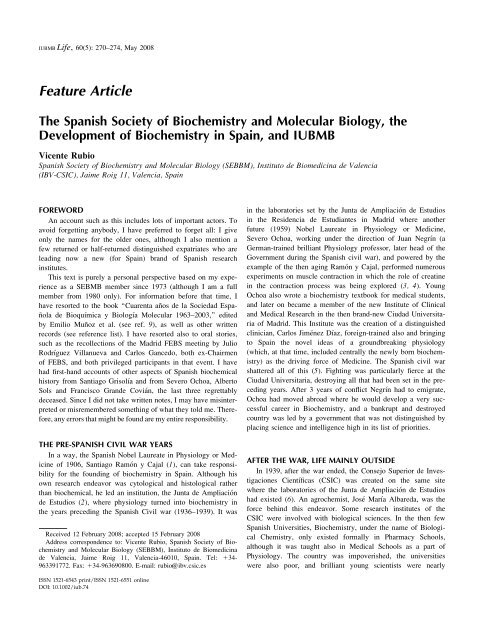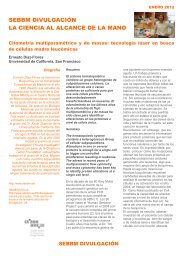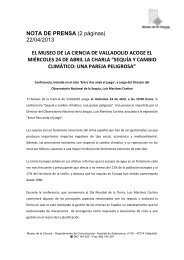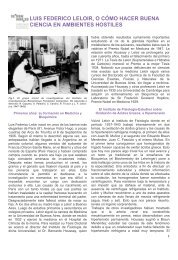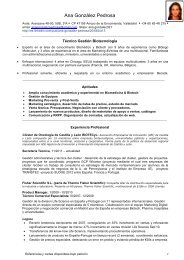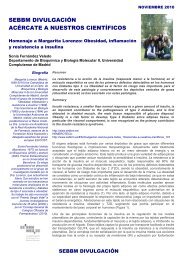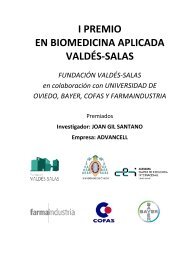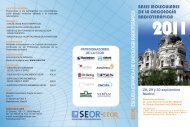The Spanish Society of Biochemistry and Molecular ... - SEBBM
The Spanish Society of Biochemistry and Molecular ... - SEBBM
The Spanish Society of Biochemistry and Molecular ... - SEBBM
You also want an ePaper? Increase the reach of your titles
YUMPU automatically turns print PDFs into web optimized ePapers that Google loves.
IUBMB Life, 60(5): 270–274, May 2008<br />
Feature Article<br />
<strong>The</strong> <strong>Spanish</strong> <strong>Society</strong> <strong>of</strong> <strong>Biochemistry</strong> <strong>and</strong> <strong>Molecular</strong> Biology, the<br />
Development <strong>of</strong> <strong>Biochemistry</strong> in Spain, <strong>and</strong> IUBMB<br />
Vicente Rubio<br />
<strong>Spanish</strong> <strong>Society</strong> <strong>of</strong> <strong>Biochemistry</strong> <strong>and</strong> <strong>Molecular</strong> Biology (<strong>SEBBM</strong>), Instituto de Biomedicina de Valencia<br />
(IBV-CSIC), Jaime Roig 11, Valencia, Spain<br />
FOREWORD<br />
An account such as this includes lots <strong>of</strong> important actors. To<br />
avoid forgetting anybody, I have preferred to forget all: I give<br />
only the names for the older ones, although I also mention a<br />
few returned or half-returned distinguished expatriates who are<br />
leading now a new (for Spain) br<strong>and</strong> <strong>of</strong> <strong>Spanish</strong> research<br />
institutes.<br />
This text is purely a personal perspective based on my experience<br />
as a SEBMB member since 1973 (although I am a full<br />
member from 1980 only). For information before that time, I<br />
have resorted to the book ‘‘Cuarenta años de la Sociedad Española<br />
de Bioquímica y Biología <strong>Molecular</strong> 1963–2003,’’ edited<br />
by Emilio Muñoz et al. (see ref. 9), as well as other written<br />
records (see reference list). I have resorted also to oral stories,<br />
such as the recollections <strong>of</strong> the Madrid FEBS meeting by Julio<br />
Rodríguez Villanueva <strong>and</strong> Carlos Gancedo, both ex-Chairmen<br />
<strong>of</strong> FEBS, <strong>and</strong> both privileged participants in that event. I have<br />
had first-h<strong>and</strong> accounts <strong>of</strong> other aspects <strong>of</strong> <strong>Spanish</strong> biochemical<br />
history from Santiago Grisolía <strong>and</strong> from Severo Ochoa, Alberto<br />
Sols <strong>and</strong> Francisco Gr<strong>and</strong>e Covián, the last three regrettably<br />
deceased. Since I did not take written notes, I may have misinterpreted<br />
or misremembered something <strong>of</strong> what they told me. <strong>The</strong>refore,<br />
any errors that might be found are my entire responsibility.<br />
THE PRE-SPANISH CIVIL WAR YEARS<br />
In a way, the <strong>Spanish</strong> Nobel Laureate in Physiology or Medicine<br />
<strong>of</strong> 1906, Santiago Ramón y Cajal (1), can take responsibility<br />
for the founding <strong>of</strong> biochemistry in Spain. Although his<br />
own research endeavor was cytological <strong>and</strong> histological rather<br />
than biochemical, he led an institution, the Junta de Ampliación<br />
de Estudios (2), where physiology turned into biochemistry in<br />
the years preceding the <strong>Spanish</strong> Civil war (1936–1939). It was<br />
Received 12 February 2008; accepted 15 February 2008<br />
Address correspondence to: Vicente Rubio, <strong>Spanish</strong> <strong>Society</strong> <strong>of</strong> <strong>Biochemistry</strong><br />
<strong>and</strong> <strong>Molecular</strong> Biology (<strong>SEBBM</strong>), Instituto de Biomedicina<br />
de Valencia, Jaime Roig 11, Valencia-46010, Spain. Tel: 134-<br />
963391772. Fax: 134-963690800. E-mail: rubio@ibv.csic.es<br />
in the laboratories set by the Junta de Ampliación de Estudios<br />
in the Residencia de Estudiantes in Madrid where another<br />
future (1959) Nobel Laureate in Physiology or Medicine,<br />
Severo Ochoa, working under the direction <strong>of</strong> Juan Negrín (a<br />
German-trained brilliant Physiology pr<strong>of</strong>essor, later head <strong>of</strong> the<br />
Government during the <strong>Spanish</strong> civil war), <strong>and</strong> powered by the<br />
example <strong>of</strong> the then aging Ramón y Cajal, performed numerous<br />
experiments on muscle contraction in which the role <strong>of</strong> creatine<br />
in the contraction process was being explored (3, 4). Young<br />
Ochoa also wrote a biochemistry textbook for medical students,<br />
<strong>and</strong> later on became a member <strong>of</strong> the new Institute <strong>of</strong> Clinical<br />
<strong>and</strong> Medical Research in the then br<strong>and</strong>-new Ciudad Universitaria<br />
<strong>of</strong> Madrid. This Institute was the creation <strong>of</strong> a distinguished<br />
clinician, Carlos Jiménez Díaz, foreign-trained also <strong>and</strong> bringing<br />
to Spain the novel ideas <strong>of</strong> a groundbreaking physiology<br />
(which, at that time, included centrally the newly born biochemistry)<br />
as the driving force <strong>of</strong> Medicine. <strong>The</strong> <strong>Spanish</strong> civil war<br />
shattered all <strong>of</strong> this (5). Fighting was particularly fierce at the<br />
Ciudad Universitaria, destroying all that had been set in the preceding<br />
years. After 3 years <strong>of</strong> conflict Negrín had to emigrate,<br />
Ochoa had moved abroad where he would develop a very successful<br />
career in <strong>Biochemistry</strong>, <strong>and</strong> a bankrupt <strong>and</strong> destroyed<br />
country was led by a government that was not distinguished by<br />
placing science <strong>and</strong> intelligence high in its list <strong>of</strong> priorities.<br />
AFTER THE WAR, LIFE MAINLY OUTSIDE<br />
In 1939, after the war ended, the Consejo Superior de Investigaciones<br />
Científicas (CSIC) was created on the same site<br />
where the laboratories <strong>of</strong> the Junta de Ampliación de Estudios<br />
had existed (6). An agrochemist, José María Albareda, was the<br />
force behind this endeavor. Some research institutes <strong>of</strong> the<br />
CSIC were involved with biological sciences. In the then few<br />
<strong>Spanish</strong> Universities, <strong>Biochemistry</strong>, under the name <strong>of</strong> Biological<br />
Chemistry, only existed formally in Pharmacy Schools,<br />
although it was taught also in Medical Schools as a part <strong>of</strong><br />
Physiology. <strong>The</strong> country was impoverished, the universities<br />
were also poor, <strong>and</strong> brilliant young scientists were nearly<br />
ISSN 1521-6543 print/ISSN 1521-6551 online<br />
DOI: 10.1002/iub.74
SPANISH SOCIETY OF BIOCHEMISTRY AND MOLECULAR BIOLOGY<br />
271<br />
always forced to emigrate or could not return. An exception<br />
was Angel Santos (7), a pr<strong>of</strong>essor <strong>of</strong> Biological Chemistry at<br />
the School <strong>of</strong> Pharmacy in Madrid, who taught, carried out<br />
research, <strong>and</strong> lobbied for biochemistry during those bleak years,<br />
being the IUB (now IUBMB) representative <strong>of</strong> Spain since the<br />
incorporation <strong>of</strong> Spain to IUB in 1955, till 1968. Angel Santos<br />
was the mentor <strong>of</strong> many <strong>Spanish</strong> biochemists, including Federico<br />
Mayor Zaragoza, widely known as UNESCO Director General<br />
(1987–1999). By contrast, Francisco Duran-Reynals (8, 9),<br />
the father <strong>of</strong> hyaluronidase <strong>and</strong> a founding father <strong>of</strong> cancer virology,<br />
was set to return to Spain from the Rockefeller Institute,<br />
but the <strong>Spanish</strong> civil war prevented this. Jordi Folch-Pi (9, 10),<br />
the creator <strong>of</strong> the chlor<strong>of</strong>orm–methanol extraction procedure,<br />
the discoverer <strong>of</strong> proteolipids <strong>and</strong> a father <strong>of</strong> Neurochemistry,<br />
went from Barcelona to Duran-Reynalds laboratory in the Rockefeller<br />
in 1936, <strong>and</strong> remained in the USA for the rest <strong>of</strong> his<br />
highly successful scientific life. In the Medical School <strong>of</strong> Valencia,<br />
the physiologist José García Blanco, trained with Negrín in<br />
Madrid <strong>and</strong> with Knoop in Germany, carried out some modest<br />
biochemical work <strong>and</strong> proposed a then very young Santiago<br />
Grisolía to emigrate to Ochoa’s laboratory in New York (9, 11).<br />
In his 30 years in the USA Grisolia demonstrated biochemically<br />
(together with P.P. Cohen <strong>and</strong> in parallel with Sarah Ratner) the<br />
reality <strong>of</strong> the urea cycle, introduced biochemistry to Kansas,<br />
<strong>and</strong> carried out important work on enzymes <strong>and</strong> on protein<br />
carbamylation. Francisco Gr<strong>and</strong>e Covián was another <strong>of</strong> these<br />
pioneer expatriate biochemists (9). He had worked also with<br />
Negrín before the war, carried out nutritional studies in Valencia<br />
during the war years as part <strong>of</strong> the effort <strong>of</strong> the legal Government<br />
to feed the population, <strong>and</strong> emigrated in 1953 to stay<br />
more than 20 years in the University <strong>of</strong> Minnesota where he<br />
developed a very successful career in nutritional biochemistry<br />
<strong>and</strong> related areas. Others who left the country at that time to<br />
carry out biochemical work (9) were Joan Oró (a founding father<br />
<strong>of</strong> origin <strong>of</strong> life biochemistry) <strong>and</strong> Carlos Villar-Palasí (a<br />
pr<strong>of</strong>essor at the University <strong>of</strong> Virginia with important contributions<br />
on glycogen metabolism <strong>and</strong> on kinases). Pedro Cuatrecasas,<br />
one <strong>of</strong> the first Pharmaceutical biochemists <strong>and</strong> a father <strong>of</strong><br />
affinity chromatography, was born in Madrid amid the civil<br />
strife, but his family soon fled the country. Marino Martínez-<br />
Carrión also developed his entire scientific career abroad, graduating<br />
from Berkeley <strong>and</strong> participating in the development <strong>of</strong><br />
biophysical biochemistry, first in the Medical College <strong>of</strong> Virginia<br />
<strong>and</strong> later in Kansas City (Missouri).<br />
ALBERTO SOLS, AND THE BIRTH OF SEB (<strong>SEBBM</strong>)<br />
AND FEBS<br />
Alberto Sols deserves a particular mention (12, 13). An<br />
M.D. in 1944, he was on good terms with the regime <strong>and</strong> spent<br />
3 years (1951–1954) in St. Louis with the Nobel Laureates in<br />
Physiology or Medicine (1947) Carl <strong>and</strong> Gerty Cori (14, 15).<br />
<strong>The</strong> laboratory <strong>of</strong> the Coris was then a Mecca for enzymology<br />
<strong>and</strong> for carbohydrate biochemistry, <strong>and</strong> thus, in addition to perfecting<br />
enzymology, Sols then made very good international<br />
contacts with many leading scientists on both sides <strong>of</strong> the Atlantic.<br />
Sols also developed a close relationship with Ochoa <strong>and</strong><br />
with the Argentinean scientist Luis Leloir, who would be later a<br />
Nobel Laureate in Chemistry (1970). Sols returned in 1954 to<br />
Madrid <strong>and</strong> developed his career in the CSIC under the protection<br />
<strong>of</strong> Albareda (at that time in Spain, protection from a big<br />
shot was a prerequisite for advance). His endeavors proved very<br />
good for <strong>Spanish</strong> <strong>Biochemistry</strong>, because he was the right man<br />
at the right place <strong>and</strong> time. Being, in a way, the internationally<br />
well known <strong>Spanish</strong> Biochemist <strong>of</strong> the time, he helped to open<br />
the windows to the external world. After years <strong>of</strong> stagnation<br />
<strong>and</strong> international isolation, Spain began to return to the international<br />
forums in 1953, when a treaty was signed with the USA,<br />
which was followed little later by the entry <strong>of</strong> the country into<br />
the UN (1955) <strong>and</strong> by the launching <strong>of</strong> the 1st <strong>Spanish</strong> Development<br />
Plan (1963) including the allocation <strong>of</strong> money for science.<br />
<strong>The</strong> country was in need <strong>of</strong> international connections, <strong>and</strong><br />
in the biochemical context, it already had a representative to the<br />
recently created IUB (16). Alberto Sols, together with no more<br />
than another 34 biochemists/physiologists, helped these connections,<br />
in large part by creating SEB (now <strong>SEBBM</strong>), the <strong>Spanish</strong><br />
<strong>Society</strong> <strong>of</strong> <strong>Biochemistry</strong> in 1963 (17), the same year that FEBS<br />
(the Federation <strong>of</strong> the European Biochemical Societies) was<br />
created (18). In this way, SEB was a founder <strong>of</strong> FEBS. In addition,<br />
SEB became the <strong>Spanish</strong> Adhering Body to IUB, <strong>and</strong>, in<br />
fact, Sols was the <strong>Spanish</strong> representative in IUB from 1968<br />
to 1972.<br />
TOWARDS INTERNATIONALIZATION OF<br />
SPANISH BIOCHEMISTRY<br />
<strong>The</strong> creation <strong>of</strong> <strong>SEBBM</strong> (I will use from here on the modern<br />
term for this society, which includes also molecular biology, as<br />
I will use IUBMB rather than IUB) was a turning point in the<br />
scientific life <strong>of</strong> Spain <strong>and</strong> in the internationalization <strong>of</strong> <strong>Spanish</strong><br />
biological science (17). It meant the separation <strong>of</strong> biochemistry<br />
from physiology in <strong>Spanish</strong> Universities, allowing biochemistry,<br />
<strong>and</strong> later on, molecular biology, to flourish. In 1966, when I<br />
entered Medical School in Valencia, it was clear to us that biochemistry<br />
was becoming the language <strong>of</strong> medicine. In my view,<br />
<strong>SEBBM</strong> was highly successful in spreading by way <strong>of</strong> its members<br />
a new creed <strong>of</strong> passion for underst<strong>and</strong>ing <strong>and</strong> for hard<br />
work, <strong>and</strong> the positivist utopia that the underst<strong>and</strong>ing <strong>of</strong> life<br />
was essential for a better life (perhaps a naïve concept; nevertheless,<br />
I still firmly believe in it). To us, this creed was very<br />
welcomed in those days <strong>of</strong> revolt against an authoritarian rule<br />
because <strong>of</strong> its reliance on reason rather than on authority.<br />
HELP FROM THE OUTSIDE AND THE<br />
GROWTH INSIDE<br />
Since its very beginning, <strong>SEBBM</strong> <strong>and</strong> the development <strong>of</strong><br />
<strong>Spanish</strong> biochemistry <strong>and</strong> molecular biology were helped by the<br />
<strong>Spanish</strong> biochemist expatriates. Severo Ochoa (19) <strong>and</strong> Santiago
272 RUBIO<br />
Grisolía were promoters <strong>of</strong> <strong>SEBBM</strong> from the very start. <strong>The</strong>y,<br />
<strong>and</strong> most other expatriates mentioned above, either trained or<br />
provided advice on choosing a laboratory where to train, to<br />
numerous young Spaniards who went to the USA (<strong>and</strong>, to a<br />
lesser extent in these years, to Europe) in search <strong>of</strong> postdoctoral<br />
experience. Although some <strong>of</strong> these postdocs remained in the<br />
United States <strong>and</strong> developed in many cases highly successful<br />
careers (9) many others returned <strong>and</strong> became the now aging,<br />
first really numerous generation <strong>of</strong> internationally-trained <strong>Spanish</strong><br />
biochemists, microbiologists, <strong>and</strong> geneticists, those that by<br />
working inside have provided the muscle, blood, <strong>and</strong> the sweat<br />
for pushing the wagon <strong>of</strong> <strong>Spanish</strong> biochemistry <strong>and</strong> molecular<br />
biology towards its present speed. <strong>The</strong>y are too many to be<br />
mentioned here without the risk <strong>of</strong> forgetting someone.<br />
While this increase in manpower was taking place, a certain<br />
degree <strong>of</strong> modernization was under way within Spain, in part<br />
related also to <strong>Spanish</strong> expatriates. An education minister, Villar-Palasí,<br />
the brother <strong>of</strong> the biochemist expatriate Carlos Villar-Palasí,<br />
called a committee <strong>of</strong> experts that included Severo<br />
Ochoa <strong>and</strong> Santiago Grisolía, to provide advice on how to modernize<br />
the <strong>Spanish</strong> Universities. This led in the late 60s to an<br />
important reshuffling <strong>and</strong> expansion <strong>of</strong> the <strong>Spanish</strong> University<br />
system, with creation <strong>of</strong> many new universities including two<br />
excellence-focused universities (called Autonomous Universities),<br />
in Madrid <strong>and</strong> Barcelona. This made room, not without<br />
trouble, for the young trainees returning from abroad, <strong>and</strong> led to<br />
development in the late 60s <strong>and</strong> 70s <strong>of</strong> new centers <strong>of</strong> science<br />
production outside Madrid <strong>and</strong> Barcelona. <strong>The</strong> influence <strong>of</strong><br />
Ochoa (19) <strong>and</strong> the funds derived from the treaty <strong>of</strong> collaboration<br />
with the USA were put to good use in the creation <strong>of</strong> the<br />
Centro de Biología <strong>Molecular</strong> (CBM; now called Centro de<br />
Biología <strong>Molecular</strong> Severo Ochoa, CBMSO), a center <strong>of</strong> the<br />
CSIC <strong>and</strong> the Autonomous University <strong>of</strong> Madrid that was conceived<br />
as state-<strong>of</strong>-the-art. <strong>The</strong> CBMSO, opened in 1975, hosted<br />
Severo Ochoa later in his life, <strong>and</strong> set the st<strong>and</strong>ard for future<br />
centers in Spain. In other parts <strong>of</strong> the country, in addition to the<br />
universities, other Institutes were being opened in the 70s, generally<br />
as part <strong>of</strong> CSIC or as joint ventures with it. <strong>The</strong>se<br />
included the Instituto de Biología Fundamental <strong>of</strong> Barcelona,<br />
the Instituto de Bioquímica Vegetal <strong>of</strong> Seville, <strong>and</strong> the Instituto<br />
de Investigaciones Citológicas (IIC) <strong>of</strong> Valencia. Shortly after<br />
the return <strong>of</strong> democracy, the IIC <strong>of</strong> Valencia was to be led by<br />
the <strong>Spanish</strong> biochemist expatriate, Santiago Grisolía. In Zaragoza,<br />
a private research institute belonging to a baby formula<br />
laboratory, Ulta, was directed by another <strong>Spanish</strong> expatriate,<br />
Francisco Gr<strong>and</strong>e-Covián. <strong>The</strong> heading by expatriates <strong>of</strong> new<br />
research centers is a constant <strong>of</strong> <strong>Spanish</strong> scientific life that continues<br />
in good shape, sometimes with mixed feelings <strong>of</strong> both<br />
the imported brains <strong>and</strong> the locals, although generally the outcome<br />
appears highly positive (20). In recent years, the Centro<br />
Nacional de Investigaciones Oncológicas (CNIO) <strong>and</strong> the Centro<br />
Nacional de Investigaciones Cardiovasculares (CNIC) were<br />
created in Madrid <strong>and</strong> are led by Mariano Barbacid (previously<br />
at Bristol Myers Squibb) <strong>and</strong> by Valentín Fuster (Mount Sinai).<br />
In Barcelona, the Centres de Regulació Genòmica (CRG) <strong>and</strong><br />
de Medicina Regenerativa (CMR) were also created recently<br />
<strong>and</strong> are directed, respectively, by Miguel Beato (Marburg, Germany)<br />
<strong>and</strong> Juan Carlos Ispizua (Salk Institute), <strong>and</strong> the Institute<br />
for Research in Biomedicine (IRB) was opened <strong>and</strong> had Joan<br />
Massagué (Sloan Kettering) as Associate Director.<br />
THE VI FEBS MEETING<br />
<strong>The</strong> year 1969 was a turning point for <strong>Spanish</strong> biochemistry<br />
in the internationalization process <strong>and</strong> also the point <strong>of</strong> reaching<br />
adulthood. It was the year when Spain became member <strong>of</strong><br />
EMBO (although not <strong>of</strong> EMBL, a decision that was postponed<br />
until 1987), <strong>and</strong> also the year in which the VI FEBS Meeting<br />
was organized in Madrid (21). This meeting added a pinch <strong>of</strong><br />
political drama to the generally peaceful life <strong>of</strong> FEBS. <strong>The</strong><br />
meeting was planned for early April under the honorary presidency<br />
<strong>of</strong> Ochoa, but, in January, the State <strong>of</strong> Exception, a sort<br />
<strong>of</strong> curfew with loss <strong>of</strong> basic rights, was established by the government<br />
as a response <strong>of</strong> the regime to the student’s uproar.<br />
Some European scientists called for a boycott <strong>of</strong> the Madrid<br />
Meeting. Ochoa on one side <strong>of</strong> the Atlantic, <strong>and</strong> the FEBS<br />
authorities <strong>and</strong> the local organizing committee on the other, had<br />
to work very hard to prevent the failure <strong>of</strong> the meeting, which<br />
finally took place in an improved political context, since the<br />
State <strong>of</strong> Exception was abolished before the Meeting began.<br />
<strong>The</strong> presence <strong>of</strong> 2,000 delegates, including several Nobel laureates<br />
<strong>and</strong> many highly distinguished biochemists attests to the<br />
meeting’s success. A poster was painted by Dalí <strong>and</strong> perhaps<br />
ranks highest in artistic quality among those used for FEBS<br />
meetings. <strong>The</strong> fact that Dalí <strong>and</strong> Ochoa were friends from the<br />
pre-civil war years (22) made <strong>of</strong> Dalí a great fan <strong>of</strong> biochemistry<br />
(23). He also painted memorable posters for the Urea Cycle<br />
Meeting organized in Valencia by Grisolia in May 1975 (24),<br />
<strong>and</strong> for the meeting celebrating, in Barcelona, the 70th anniversary<br />
<strong>of</strong> Ochoa (see ref. 22). In the case <strong>of</strong> the VI FEBS meeting,<br />
a stamp was also printed by the <strong>Spanish</strong> Postal System to<br />
commemorate the meeting. Only many years later, in 1996, was<br />
another FEBS meeting (the 24th) to take place in Spain, in Barcelona.<br />
No IUBMB Congress has ever been held in Spain; it is<br />
scheduled for 2012, in Seville.<br />
FRESH AIR FOR SPAIN AND THE NORMALIZATION<br />
OF SPANISH SCIENCE<br />
With the death <strong>of</strong> Franco in November 1975, a rapid process<br />
<strong>of</strong> institutional normalization <strong>and</strong> modernization <strong>of</strong> Spain took<br />
place. This included a democratic Constitution <strong>and</strong> the advent<br />
<strong>of</strong> democratic Governments. <strong>The</strong> CSIC got a new set <strong>of</strong> more<br />
open rules (1977), <strong>and</strong>, after a failed attempt led by the Minister<br />
for Research <strong>and</strong> Universities, Federico Mayor (a biochemist<br />
trained with the Nobel Laureate Sir Hans Krebs), the University<br />
System was reformed again (1983), this time under the rule <strong>of</strong><br />
the Socialist Party. This reform <strong>and</strong> the passing <strong>of</strong> the Law for
SPANISH SOCIETY OF BIOCHEMISTRY AND MOLECULAR BIOLOGY<br />
273<br />
Science (1986) fostered rapid scientific growth. <strong>The</strong> entry <strong>of</strong><br />
Spain into NATO (1981/1986), <strong>and</strong> particularly into the European<br />
Union (1986) completed the process <strong>of</strong> normalization <strong>of</strong><br />
the international links with Spain. During these years <strong>of</strong> Socialist<br />
Party rule, Spain established the workings <strong>of</strong> its science system,<br />
based on the competitive funding <strong>of</strong> science <strong>and</strong> <strong>of</strong> peer<br />
review orchestrated by a neutral evaluation agency (ANEP),<br />
with funds provided by a 4-year National Plan, <strong>and</strong> with an<br />
Inter-ministerial Committee administering <strong>and</strong> overseeing the<br />
process. A number <strong>of</strong> <strong>Spanish</strong> biochemists including prominently<br />
the late Roberto Fernández de Caleya, were among the<br />
group <strong>of</strong> scientists that drew the basic lines <strong>of</strong> the system. <strong>The</strong><br />
entry into the EU greatly spurred research thanks largely to<br />
the skills <strong>of</strong> <strong>Spanish</strong> negotiators that introduced the Structural<br />
Funds (FEDER) <strong>and</strong> the idea <strong>of</strong> positive discrimination for science<br />
initiatives that included groups from the countries being<br />
accepted into the EU (Portugal, Spain <strong>and</strong> Greece at the time).<br />
Never again, as in the immediate years after incorporation into<br />
the EU, has Spain had such a large mass <strong>of</strong> <strong>Spanish</strong> scientists<br />
leading or participating in European initiatives. This had a great<br />
impact in setting strong links between <strong>Spanish</strong> <strong>and</strong> European<br />
groups <strong>and</strong> in rendering <strong>Spanish</strong> scientists very accustomed to<br />
the day-to-day uses <strong>of</strong> international science. On the other h<strong>and</strong>,<br />
Structural funds have pumped money into the science system<br />
<strong>and</strong> into the building <strong>of</strong> new scientific institutes <strong>and</strong> the incorporation<br />
<strong>of</strong> scientific infrastructures. This has allowed to close<br />
the gap between the meager science funding <strong>of</strong> the pre-EU era,<br />
<strong>and</strong> the more up-to-date funding <strong>of</strong> nowadays. With the entry <strong>of</strong><br />
Eastern European countries in the EU, Spain is losing its privileged<br />
position as a receiver <strong>of</strong> Structural funds, but, nevertheless,<br />
it would not be expected that the country were to revert to<br />
lower science budgets, although growth might slow down.<br />
TODAY’S SPANISH BIOCHEMISTRY AND MOLECULAR<br />
BIOLOGY IN PERSPECTIVE<br />
When the state <strong>of</strong> <strong>Spanish</strong> <strong>Biochemistry</strong>, <strong>Molecular</strong> Biology<br />
<strong>and</strong> allied disciplines <strong>of</strong> today is compared with the state prevailing<br />
30 years ago, there are reasons for being proud. After<br />
coming to a st<strong>and</strong>still in the late 80s <strong>and</strong> early 90s, funds for<br />
science have steadily increased in Spain, <strong>and</strong> the public contribution<br />
is nowadays 1% <strong>of</strong> the GNP, with the present government<br />
having tried hard (although not fully succeeding) to keep<br />
its word to increase research funds by 25% yearly (25). Science,<br />
<strong>and</strong> particularly biomedical <strong>and</strong> molecular disciplines, are in the<br />
limelight <strong>of</strong> <strong>Spanish</strong> life (26). Press records <strong>of</strong> biological <strong>and</strong><br />
biomedical advances are numerous <strong>and</strong> quite accurate. <strong>Spanish</strong><br />
biochemists <strong>and</strong> molecular biologists are visible in international<br />
journals <strong>and</strong> in scientific forums such as congresses <strong>and</strong> meetings.<br />
New Statutes for the CSIC were approved in 1993 <strong>and</strong><br />
2000, <strong>and</strong> this research institution, <strong>of</strong> which about 50% is biological-biomedical,<br />
has grown steadily, being now the center <strong>of</strong><br />
a change <strong>of</strong> status to adapt it to the challenges <strong>of</strong> 21st century<br />
research. <strong>The</strong> University has modified again its rules in 2007, in<br />
part to facilitate the recruitment <strong>of</strong> scientists. <strong>The</strong> Ramón y<br />
Cajal <strong>and</strong> Juan de la Cierva programs have allowed recruitment<br />
<strong>of</strong> many senior <strong>and</strong> junior postdocs. <strong>The</strong> Ministry <strong>of</strong> Health has<br />
taken up biomedical research as the centerpiece <strong>of</strong> its performance,<br />
<strong>and</strong> has opened physical (CNIO <strong>and</strong> CNIC) <strong>and</strong> virtual<br />
centers for biomedical research (seven Centros de Investigación<br />
Biomédica en Red, or, in short, CIBERs; <strong>and</strong> even more Networks,<br />
called RETICS), allowing the contracting <strong>of</strong> a large<br />
number <strong>of</strong> scientists. In addition, the Health Ministry has<br />
funded three <strong>Spanish</strong> centers <strong>of</strong> regenerative medicine <strong>and</strong> has<br />
passed a law regulating biomedical research, creating the bases<br />
for structured research within the Health System. Large hospitals<br />
have organized research foundations, <strong>and</strong> a host <strong>of</strong> young<br />
researchers has been incorporated into them, perhaps with<br />
mixed results, but, nevertheless, increasing the level <strong>of</strong> science<br />
performance <strong>of</strong> medical institutions. Several regions, including<br />
Catalonia <strong>and</strong> Madrid, have acquired the status <strong>of</strong> Bioregions.<br />
Many classical centers for research have exp<strong>and</strong>ed a lot <strong>and</strong><br />
sport new, well furbished buildings, whereas numerous new<br />
institutes <strong>and</strong> research centers dedicated to biomedical subjects<br />
have been created all over the country by the central or by the<br />
local governments.<br />
And yet, there are many challenges <strong>and</strong> reasons for strong<br />
concern. Although players in the game, we are not yet in the<br />
front line. <strong>The</strong> science system in Spain is still quite closed to<br />
foreign talent (27–29). <strong>The</strong>re is no statute regulating specifically<br />
the activity <strong>of</strong> the public research worker. <strong>The</strong> bureaucratic<br />
machine for hiring people <strong>and</strong> for using funds can suffocate<br />
<strong>Spanish</strong> science if it is not soon abolished or replaced by more<br />
sensible <strong>and</strong> specific control systems (30). Publication <strong>and</strong> patent<br />
record is reasonable but not high. <strong>The</strong>re is too little pharmaceutical<br />
<strong>and</strong> biotechnology-based industry, <strong>and</strong> thus scientists<br />
have the universities <strong>and</strong> the public system as the only niche<br />
for work. In most cases, the universities are not science-driven,<br />
<strong>and</strong> their recruitment <strong>of</strong> personnel always includes tenure. In<br />
fact, staff pr<strong>of</strong>essors <strong>and</strong> scientists in the public system<br />
(including the Universities <strong>and</strong> the CSIC) are civil servants, a<br />
status that some think should be abolished (20). <strong>The</strong>re are few<br />
charities devoted to science, <strong>and</strong> those that exist follow a policy<br />
<strong>of</strong> marginal science support rather than creating stable, self<br />
managed, research centers <strong>and</strong> funds for specific purposes. Private<br />
universities are not real players in science. Concerning the<br />
international status <strong>of</strong> our scientists, relatively few <strong>Spanish</strong> scientists<br />
win international awards or lead EU grants. With the<br />
growth <strong>of</strong> Asian countries, we are at risk <strong>of</strong> falling again into<br />
scientific (<strong>and</strong> economic) irrelevance. This is at odds with<br />
claims from all parties involved, including <strong>SEBBM</strong>, that we<br />
should build a knowledge-based society <strong>and</strong> economic system.<br />
All these concerns are serious but can be considered minor by<br />
comparison with the leap that <strong>Spanish</strong> science, <strong>and</strong> in particular<br />
<strong>Spanish</strong> biochemistry <strong>and</strong> molecular biology, has made since<br />
the days <strong>of</strong> Alberto Sols. This leap has been largely possible<br />
through the effort <strong>of</strong> the Spaniards, but it has included as key<br />
support the interaction with international bodies such as FEBS
274 RUBIO<br />
<strong>and</strong> IUBMB. <strong>Spanish</strong> biochemists would be happy <strong>and</strong> ready to<br />
return this help by serving in these international bodies. <strong>The</strong><br />
full support <strong>of</strong> <strong>SEBBM</strong>, now a society <strong>of</strong> over 3,500 members,<br />
in the organization <strong>of</strong> the IUBMB Congress <strong>of</strong> 2012 in Seville<br />
will be a pro<strong>of</strong> <strong>of</strong> the commitment <strong>of</strong> Spain with IUBMB <strong>and</strong><br />
with world biochemistry <strong>and</strong> molecular biology.<br />
REFERENCES<br />
1. Ramón y Cajal, S. (1989) Recollections <strong>of</strong> My Life. MIT Press, Cambridge.<br />
2. Before the CSIC: the JAE. http://www.csic.es/historia.dolengua5en.<br />
3. Ochoa, S. (1980) <strong>The</strong> pursuit <strong>of</strong> a hobby. Annu. Rev. Biochem. 49, 1–<br />
30.<br />
4. Santesmases, M. J. (2001) Severo Ochoa (1905–1993): the changing<br />
world <strong>of</strong> biochemistry. Trends Biochem. Sci. 26, 140–142.<br />
5. Preston, P. (2007) <strong>The</strong> <strong>Spanish</strong> Civil War. Reaction, Revolution, <strong>and</strong><br />
Revenge. W. W. Norton, New York.<br />
6. Rideal, E. K. (1950) <strong>The</strong> <strong>Spanish</strong> Higher Council for Scientific<br />
Research. Nature 165, 790–791.<br />
7. Mayor Zaragoza, F. (2005) Homage to Angel Santos Ruiz. An. R. Acad.<br />
Nac. Med. (Madr.) 122, 506–514.<br />
8. Gardner, W. U. (1958) Francisco Duran-Reynals, 1899–1958. Cancer<br />
Res. 18, 1352–1353.<br />
9. Pellicer, A. (2004) Contribuciones de los científicos españoles en Estados<br />
Unidos a la bioquímica. In Cuarenta años de la Sociedad Española<br />
de Bioquímica y Biología <strong>Molecular</strong> 1963–2003 (Muñoz, E., Santesmases,<br />
M. J., Romero, A., <strong>and</strong> Ávila, J., eds), pp. 227–248, Sociedad<br />
Estatal de Conmemoraciones Culturales, SA, Madrid.<br />
10. Lees, M. B. (1998) A History <strong>of</strong> proteolipids: a personal memoir. Neurochem.<br />
Res. 23, 261–271.<br />
11. Aupí, V. (1998) Santiago Grisolía. Apuntes para la historia biológica<br />
del hombre. Universidad Politécnica de Valencia.<br />
12. Gancedo, C. <strong>and</strong> Aragón, J. J. <strong>The</strong> presence <strong>of</strong> Alberto Sols in modern<br />
biochemical research. Available at http://www.fundacionareces.es/albertosols.htm.<br />
13. Santesmases, M. J. (1998) Alberto Sols. Instituto de Cultura Juan Gil<br />
Albert, Diputación de Alicante-Ayuntamieno de Sax, Alicante.<br />
14. Cori, C.F. (1969) <strong>The</strong> call <strong>of</strong> science. Annu. Rev. Biochem. 38, 1–20.<br />
15. Kalkar, H. M. (1958) Gerty T. Cori, biochemist. Science 128, 16–17.<br />
16. Kamminga, H. (1999) Internationalizing biochemistry: the 1949 congress<br />
in context. Trends Biochem. Sci. 24, 404–408.<br />
17. Santesmases, M. J., <strong>and</strong> Muñoz, E. (1997) Scientific organizations in<br />
Spain (1950–1970): social isolation <strong>and</strong> international legitimation <strong>of</strong><br />
biochemists <strong>and</strong> molecular biologists on the periphery. Soc. Stud. Sci.<br />
27, 187–219.<br />
18. Feldman, H. (ed.) (2004) Forty Years <strong>of</strong> FEBS. 1964 to 2003. A Memoir.<br />
Blackwell Publishing, Oxford.<br />
19. Santesmases, M. J. (2000) Severo Ochoa <strong>and</strong> the biomedical sciences in<br />
Spain under Franco, 1959–1975. Isis 91, 706–734.<br />
20. Barbacid, M. (2007) Returning home. Cell 129, 641–644.<br />
21. <strong>The</strong> editor (1969) FEBS in Spain. Nature 221, 702–703.<br />
22. Dalí, S. (1976) My homage to Severo Ochoa. In Reflections on biochemistry.<br />
In honor <strong>of</strong> Severo Ochoa (Kornberg, A., Horecker, B. L.,<br />
Cornudella, L., <strong>and</strong> Oró, J., eds.) Pergamon Press, Oxford, New York.<br />
23. Guardiola, E. <strong>and</strong> Baños, J. E. (2003) Dalí <strong>and</strong> the double helix. Nature<br />
423, 917.<br />
24. Grisolia, S., Báguena, R., <strong>and</strong> Mayor, F. (eds) (1976) <strong>The</strong> Urea Cycle.<br />
Wiley, New York.<br />
25. Schiermeier, Q. (2004) Spain aims at premier league. Nature 431, 488–489.<br />
26. <strong>The</strong> editor (2004) Ending the pain in Spain. Nature 428, 1.<br />
27. Pickin S. (2001) Spain is a closed culture to foreign researchers. Nature<br />
410, 627.<br />
28. van Raaij, M. (2004) New law does little to ease research pain in Spain.<br />
Nature 428, 365.<br />
29. Lombardía, M. O. (2004) Spain: politicians need to challenge the status<br />
quo. Nature 428, 365.<br />
30. <strong>The</strong> editor (2007) Independence day Nature 446, 347–348.


